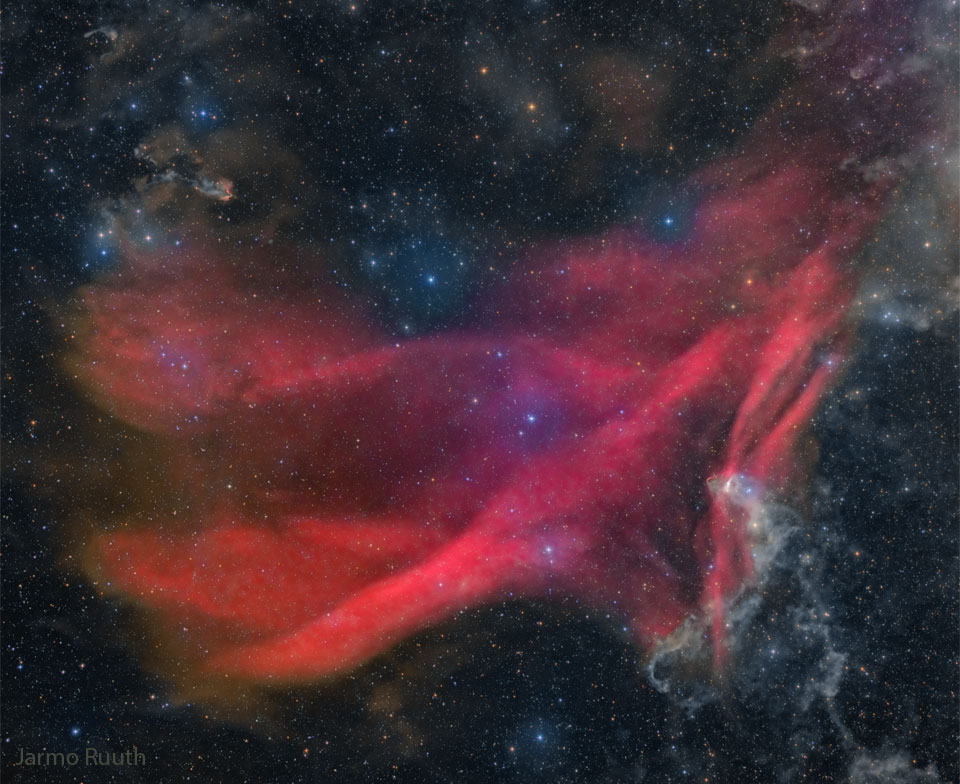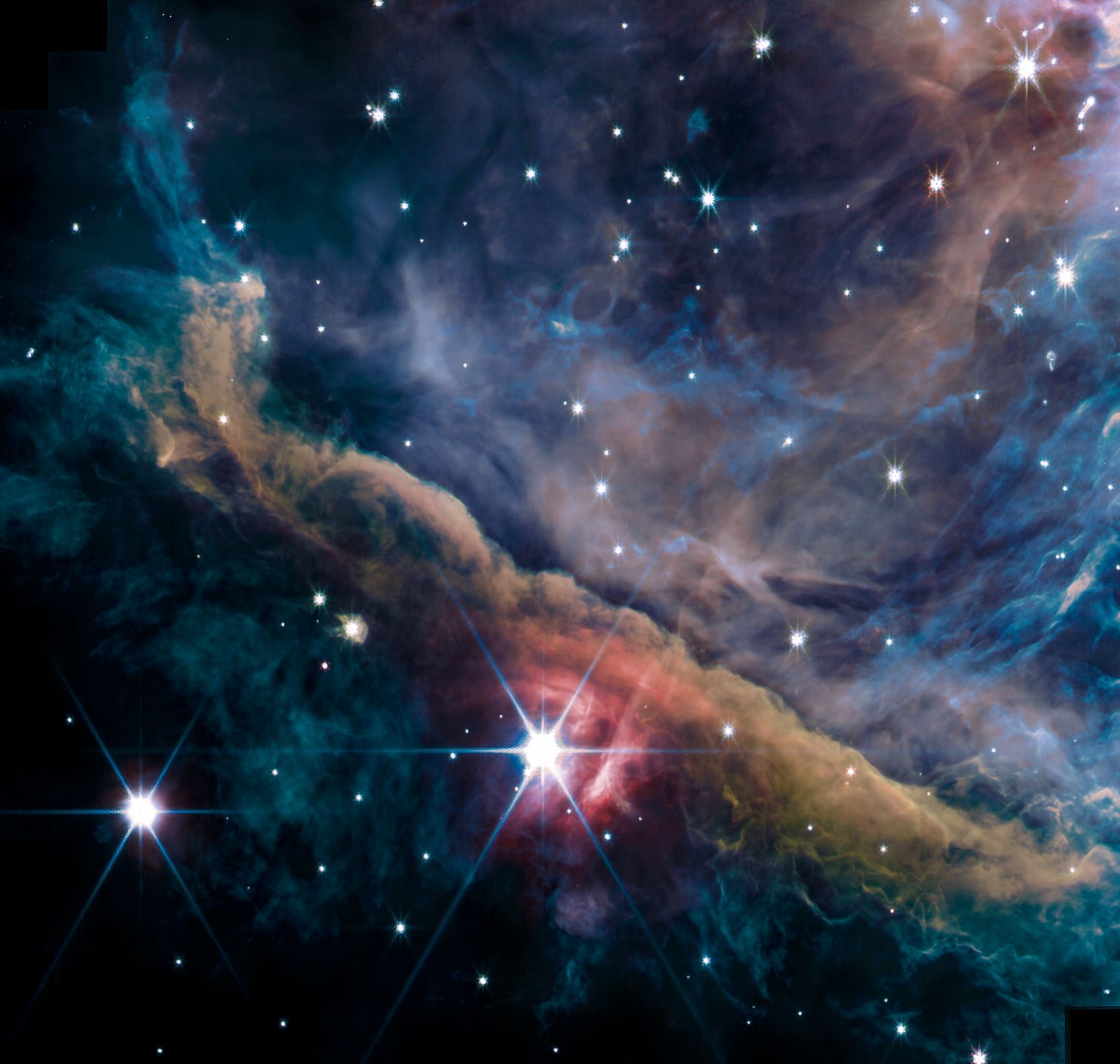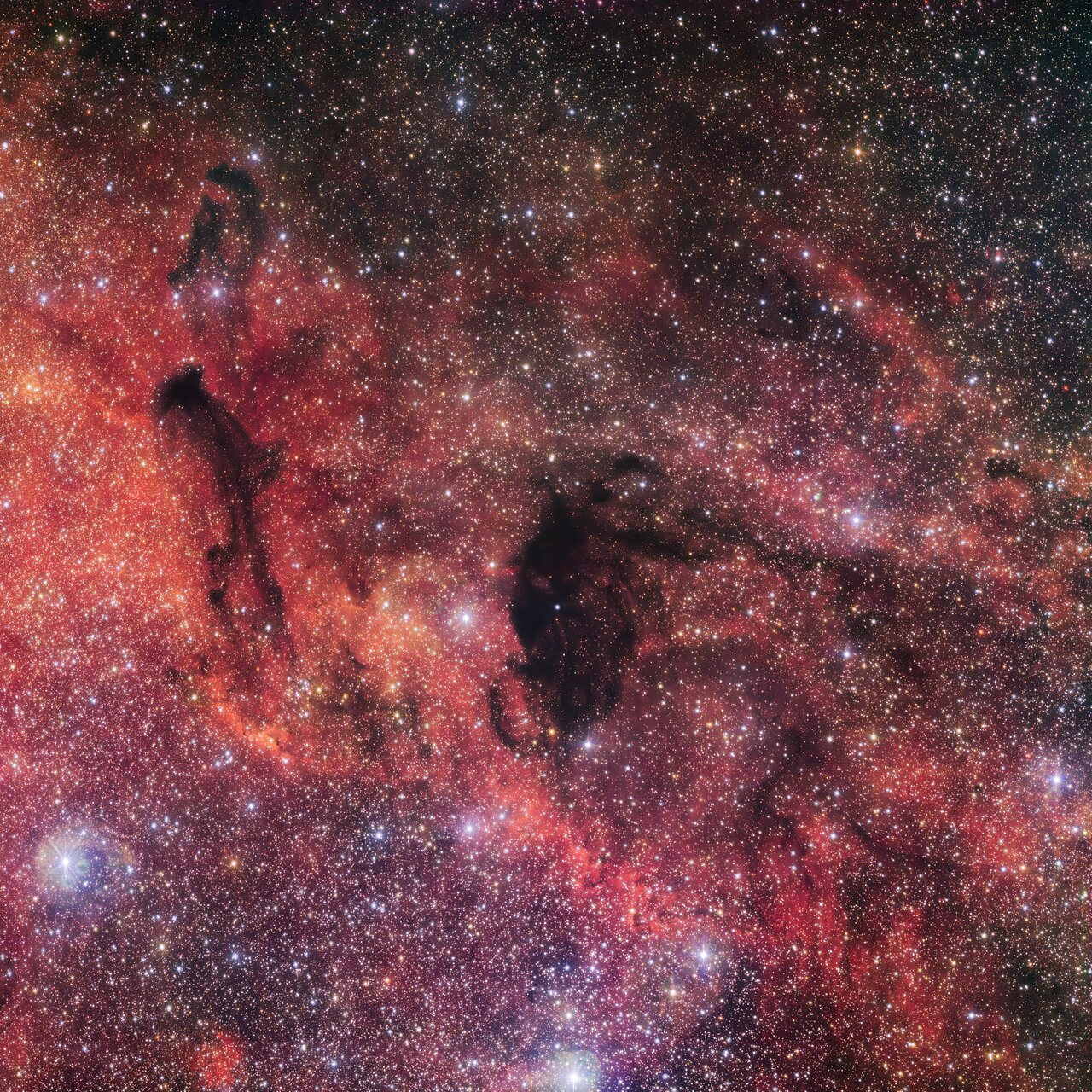Blog
It is one of the largest nebulas on the sky — why isn’t it better known? Roughly the same angular size as the Andromeda Galaxy, the Great Lacerta Nebula can be found toward the constellation of the Lizard (Lacerta). The emission nebula is difficult to see with wide-field binoculars because it is so faint, but also usually difficult to see with a large telescope because it is so great in angle — spanning about three degrees. The depth, breadth, waves, and beauty of the nebula — cataloged as Sharpless 126 (Sh2-126) — can best be seen and appreciated with a long duration camera exposure. The featured image is one such combined exposure — in this case 10 hours over five different colors and over six nights during this past June and July at the IC Astronomy Observatory in Spain. The hydrogen gas in the Great Lacerta Nebula glows red because it is excited by light from the bright star 10 Lacertae, one of the bright blue stars just above the red-glowing nebula’s center. The stars and nebula are about 1,200 light years distant.

Edward Calhoun King (September 14, 1949 – August 22, 2018) was an American musician. He was a guitarist for the psychedelic rock band Strawberry Alarm Clock and guitarist and bassist for the Southern rock band Lynyrd Skynyrd from 1972 to 1975 and again from 1987 to 1996.
King was born in the Los Angeles suburb of Glendale, California. He was one of the founding members of the LA-based Strawberry Alarm Clock, a mid-1960s pop psychedelic rock band. The band’s largest success was with the 1967 single “Incense and Peppermints“, which reached No. 1 on the Billboard Hot 100. While with the band he played both electric guitar and bass guitar. The band’s popularity waned considerably in the early 1970s. Faced with the loss of their recording contract with Uni Records and with internal conflicts over musical direction, Strawberry Alarm Clock disbanded in early 1972. King opted to remain in the South, inspired by an up-and-coming band called Lynyrd Skynyrd.
more...
Joseph Jarman (September 14, 1937 – January 9, 2019) was an American jazz musician, composer, poet, and Shinshu Buddhist priest. He was one of the first members of the Association for the Advancement of Creative Musicians and a member of the Art Ensemble of Chicago.
He was born in Pine Bluff, Arkansas, United States. Jarman grew up in Chicago, Illinois. At DuSable High School, he studied drums with Walter Dyett, switching to saxophone and clarinet when he joined the United States Army after graduation. During his time there, he was part of the 11th Airborne Division Band for a year.
more...Israel López Valdés (September 14, 1918 – March 22, 2008), better known as Cachao (/kəˈtʃaʊ/ kə-CHOW), was a Cuban double bassist and composer. Cachao is widely known as the co-creator of the mambo and a master of the descarga (improvised jam sessions). Throughout his career he also performed and recorded in a variety of music styles ranging from classical music to salsa. An exile in the United States since the 1960s, he only achieved international fame following a career revival in the 1990s.
Born into a family of musicians in Havana, Cachao and his older brother Orestes were the driving force behind one of Cuba’s most prolific charangas, Arcaño y sus Maravillas. As members of the Maravillas, Cachao and Orestes pioneered a new form of ballroom music derived from the danzón, the danzón-mambo, which subsequently developed into an international genre, mambo. In the 1950s, Cachao became famous for popularizing improvised jam sessions known as descargas. He emigrated to Spain in 1962, and moved to the United States in 1963, starting a career as a session and live musician for a variety of bands in New York during the rise of boogaloo, and later, salsa.
In the 1970s, Cachao fell into obscurity after moving to Las Vegas and later Miami, releasing albums sporadically as a leader. In the 1990s, he was re-discovered by actor Andy García, who brought him back to the forefront of the Latin music scene with the release of a documentary and several albums. Before his death in 2008, Cachao had earned a star on the Hollywood Walk of Fame and several Grammy Awards. He is ranked number 24 on Bass Player magazine’s list of “The 100 Greatest Bass Players of All Time”.
more...JWST views the Universe, are able to penetrate dust, which gives us a view into regions impossible to see in shorter wavelengths, such as the visible spectrum.
Scientists have, therefore, been very excited to use the telescope to study star formation and learn new details about the process that have heretofore been difficult to see. The new image focuses on a structure called the Orion Bar, running diagonally from the top left to the bottom right. Light from a cluster of young, hot stars called the Trapezium cluster illuminates the scene from the top right corner; this harsh, ionizing ultraviolet light is slowly eroding the bar away.
This is one of the processes involved in what astronomers call feedback – when wind or radiation from a stellar object pushes material away, reducing or quenching star formation. They also produce complex shapes and structures in a molecular cloud, including filaments and cavities, both of which have been captured in the new image.
Other objects in the image include globules (dense clumps of material with baby stars inside) and a young growing star with a disk of material around it. That disk is being evaporated from the outside by the radiation from the Trapezium stars. Nearly 180 of these objects, called proplyds, have been found in the Orion nebula.
The brightest star you see in the image is called θ2 Orionis A, and it’s one member of a multiple-star system next to the Trapezium Cluster, which is also known as θ1 Orionis. Interestingly, θ2 Orionis A is also, in itself, a triple-star system.
Although it appears very bright in the JWST image, θ2 Orionis A can only be seen by the naked eye from Earth in regions not significantly affected by light pollution. Nevertheless, it’s very hot, over 100,000 times more intrinsically bright than the Sun.

Douglas R. Ewart (born 13 September 1946 in Kingston, Jamaica) is a Jamaican multi-instrumentalist and instrument builder. He plays sopraninoand alto saxophones, clarinets, bassoon, flute, bamboo flutes (shakuhachi, ney, and panpipes), and didgeridoo; as well as Rastafarian hand drums(nyabingi, repeater, and bass).
Ewart emigrated to the United States in June 1963 (coming to Chicago) and became associated with the Association for the Advancement of Creative Musicians (AACM) in 1967, studying with Joseph Jarman and Roscoe Mitchell. He served as that organization’s president from 1979 to 1986.
He has performed or recorded with J. D. Parran, Muhal Richard Abrams, Art Ensemble of Chicago, Anthony Braxton, Alvin Curran, Anthony Davis, Robert Dick, Von Freeman, Joseph Jarman, Amina Claudine Myers, Roscoe Mitchell, James Newton, Rufus Reid, Wadada Leo Smith, Cecil Taylor, Richard Teitelbaum, Henry Threadgill, Hamid Drake, Don Byron, Malachi Favors Maghostut, and George Lewis.
In 1992, Ewart collaborated with Canadian artist Stan Douglas on the video installation Hors-champs which was featured at documenta 9 in Kassel, Germany. The installation features Ewart in an improvisation of Albert Ayler’s “Spirits Rejoice” with musicians George Lewis, Kent Carter and Oliver Johnson.
He has lived in Minneapolis, Minnesota since 1990. His father, Tom, was a cricket umpire.
more...William Smith “Bill” Monroe (/mənˈroʊ/; September 13, 1911 – September 9, 1996) was an American mandolinist, singer, and songwriter, who created the bluegrass music genre. Because of this, he is often called the “Father of Bluegrass“.
The genre takes its name from his band, the Blue Grass Boys, who named their group for the bluegrass of Monroe’s home state of Kentucky.
Bill was of Scottish and English heritage. Because his older brothers Birch and Charlie already played the fiddle and guitar, Bill was resigned to playing the less desirable mandolin. He recalled that his brothers insisted that he remove four of the mandolin’s eight strings so he would not play too loudly.
more...Tony Russell “Charles” Brown (September 13, 1922 – January 21, 1999) was an American singer and pianist whose soft-toned, slow-paced nightclub style influenced West Coast blues in the 1940s and 1950s. Between 1949 and 1952, Brown had seven Top 10 hits in the U.S. Billboard R&Bchart. His best-selling recordings included “Driftin’ Blues” and “Merry Christmas Baby“.
Brown was born in Texas City, Texas. As a child he loved music and received classical music training on the piano. He graduated from Central High School in Galveston, Texas, in 1939 and Prairie View A&M College in 1942 with a degree in chemistry. He then became a chemistry teacher at George Washington Carver High School in Baytown, Texas, a mustard gas worker at the Pine Bluff Arsenal at Pine Bluff, Arkansas, and an apprentice electrician at a shipyard in Richmond, California, before settling in Los Angeles in 1943.
more...Leon Brown “Chu” Berry (September 13, 1908 – October 30, 1941) was an American jazz tenor saxophonist during the 1930s. According to music critic Gary Giddins, musicians called him “Chu” either because he chewed on the mouthpiece of his saxophone or because he had a Fu Manchu mustache. Berry was born in Wheeling, West Virginia. He graduated from Lincoln High School, in Wheeling, then attended West Virginia State College for three years. His sister Ann played piano. Berry became interested in music at an early age, playing alto saxophone, at first with local bands. He was inspired to take up the tenor saxophone after hearing Coleman Hawkins on tour.
more...The dark clouds in this image, taken from ESO’s Paranal Observatory in Chile, almost resemble something supernatural, like the wispy trails of ghosts in the sky. But there is no need to call the ghostbusters! These clouds, known as Barnard 92 (right) and Barnard 93 (left) are dark nebulae: they look pitch black because the dense gas and dust they contain block out the background light, creating these hazy ghostlike features. These nebulae are stellar nurseries, where new stars are born out of the collapsing dense gas and dust. This whole region of space imaged here is actually part of a much larger stellar complex, called the Small Sagittarius Star Cloud (or Messier 24, catalogued by Charles Messier in 1764). This area is so rich in stars that it is clearly visible to the naked eye during dark nights, in the constellation of Sagittarius. This image was taken with an enormous 268 million pixel camera called OmegaCAM on the VLT Survey Telescope. OmegaCAM is designed for capturing wide fields like this image, where you could impressively fit four full Moons. This image is part of the VST Photometric Hα Survey of the Southern Galactic Plane and Bulge (VPHAS+), which has mapped diffuse nebulae as well as both young and evolved stars in our galaxy.

Maria Muldaur (born Maria Grazia Rosa Domenica D’Amato; September 12, 1943) is an American folk and blues singer who was part of the American folk music revival in the early 1960s. She recorded the 1973 hit song “Midnight at the Oasis” and continues to record albums in the folk, blues, early jazz, gospel, country, and R&B traditions.
She was the wife of musician Geoff Muldaur and is the mother of singer-songwriter Jenni Muldaur.
Muldaur was born in Greenwich Village, New York City, where she attended Hunter College High School.
Muldaur cites as early musical influences classic country music by Kitty Wells, Hank Williams, Hank Snow, Hank Thompson, Ernest Tubb, and Bob Wills and the Texas Playboys; Alan Freed “rock ‘n’ roll” shows; and doo-wop groups such as The Platters and The Five Satins.
more...
Neil Ellwood Peart OC (/pɪərt/; September 12, 1952 – January 7, 2020) was a Canadian-American musician, songwriter, and author, best known as the drummer and primary lyricist of the rock band Rush. Peart earned numerous awards for his musical performances, including an induction into the Modern Drummer Readers Poll Hall of Fame in 1983, making him the youngest person ever so honoured. Known to fans by the nickname ‘The Professor’, his drumming was renowned for its technical proficiency and his live performances for their exacting nature and stamina.
Peart was born in Hamilton, Ontario, and grew up in Port Dalhousie (now part of St. Catharines). During adolescence, he floated between regional bands in pursuit of a career as a full-time drummer. After a discouraging stint in England, Peart returned home to concentrate on music where he joined Rush, a Torontoband, in mid-1974, six years after its formation. Together they released nineteen studio albums, with ten exceeding a million copies sold in the United States. Billboard ranks the band third for the “most consecutive gold or platinum albums by a rock band”.
Early in his career, Peart’s performance style was deeply rooted in hard rock. He drew most of his inspiration from drummers such as Keith Moon, Ginger Baker, and John Bonham, players who were at the forefront of the British hard rock scene. As time passed, he began to emulate jazz and big band musicians Gene Krupa and Buddy Rich. In 1994, Peart became a friend and pupil of jazz instructor Freddie Gruber.[9][10] It was during this time that Peart revamped his playing style by incorporating jazz and swing components.
In addition to serving as Rush’s primary lyricist, Peart published several memoirs about his travels. His lyrics for Rush addressed universal themes and diverse subjects including science fiction, fantasy, and philosophy, as well as secular, humanitarian, and libertarian themes. Peart wrote a total of seven nonfiction books focused on his travels and personal stories. He also coauthored with Kevin J. Anderson three steampunk fantasy novels based on Rush’s final album, Clockwork Angels. The two also wrote a dark fantasy novella, Drumbeats, inspired by Peart’s travels in Africa.
On December 7, 2015, Peart announced his retirement from touring in an interview with Drumhead Magazine. In January 2018, bandmate Alex Lifesonn confirmed that Rush had disbanded also due to Peart’s health issues. During his last years Peart lived in Santa Monica, California, with his wife, Carrie Nuttall, and daughter. After a three and a half year illness, Peart died of glioblastoma on January 7, 2020, at age 67.
more...“Papa” John DeFrancesco (born September 12, 1940 Philadelphia, PA) is an American jazz organist and vocalist, and father of Joey DeFrancesco and Johnny DeFrancesco.
more...Bill Jennings (September 12, 1919 – November 29, 1978) was an American jazz guitarist and composer.
Recording as both a leader and a sideman, Jennings has been called “the architect of soul jazz” and has influenced on jazz, soul, R&B, and blues guitar. B.B. King often mentioned Jennings as one of biggest influences. Jennings recorded with such artists as Willis “Gator” Jackson, Brother Jack McDuff, Leo Parker, Bill Doggett, Louis Jordan, King Curtis, Louis Armstrong, and Ella Fitzgerald and unique in his ability to play in many styles, including swing, bop, jump blues, R&B, and pop. Jennings played on “Fever” by Little Willie John, which made the Billboard R&B chart in the US and peaked at number 24 on the BillboardHot 100.
A left-handed player, Jennings played guitar upside down, with the high strings at the top, which gave him a different approach to phrasing and bending the strings. Later in his career, he lost a finger on his fretting hand and began playing bass guitar.
more...William Alonzo “Cat” Anderson (September 12, 1916 – April 29, 1981) was an American jazz trumpeter known for his long period as a member of Duke Ellington‘s orchestra and for his wide range, especially his ability to play in the altissimo register.
Born in Greenville, South Carolina, Anderson lost both parents when he was four years old, and was sent to live at the Jenkins Orphanage in Charleston, where he learned to play trumpet. Classmates gave him the nickname “Cat” (which he used all his life) based on his fighting style. He toured and made his first recording with the Carolina Cotton Pickers, a small group based at the orphanage. After leaving the Cotton Pickers, Anderson played with guitarist Hartley Toots, Claude Hopkins‘ big band, Doc Wheeler’s Sunset Orchestra (1938–1942), with whom he also recorded, Lucky Millinder, the Erskine Hawkins Orchestra, Sabby Lewis‘s Orchestra, and Lionel Hampton, with whom he recorded the classic “Flying Home No. 2”.
more...More Posts
- World Music with Fargana Qasimova
- Daily Roots with U Roy
- The Cosmos with LL Ori
- Al Foster Day
- Harold Land Day
- Frank Butler Day
- World Music with Bari Siddiqui
- Daily Roots with Scientist & Roots Radics
- The Cosmos with NGC 3614
- Fred Frith Day
- Noble “Thin Man” Watts Day
- World Music with Brenda Fassie
- Daily Roots with Rod Taylor
- The Cosmos with Comet PanSTARRS C/2016R2
- Otis Blackwell Day
- Bill Doggett Day
- World Music with Javier Conde
- Daily Roots with Big Youth
- RHYTHM ROOTS WORKSHOP 2-13 & 15-18
- The Cosmos with NGC 521